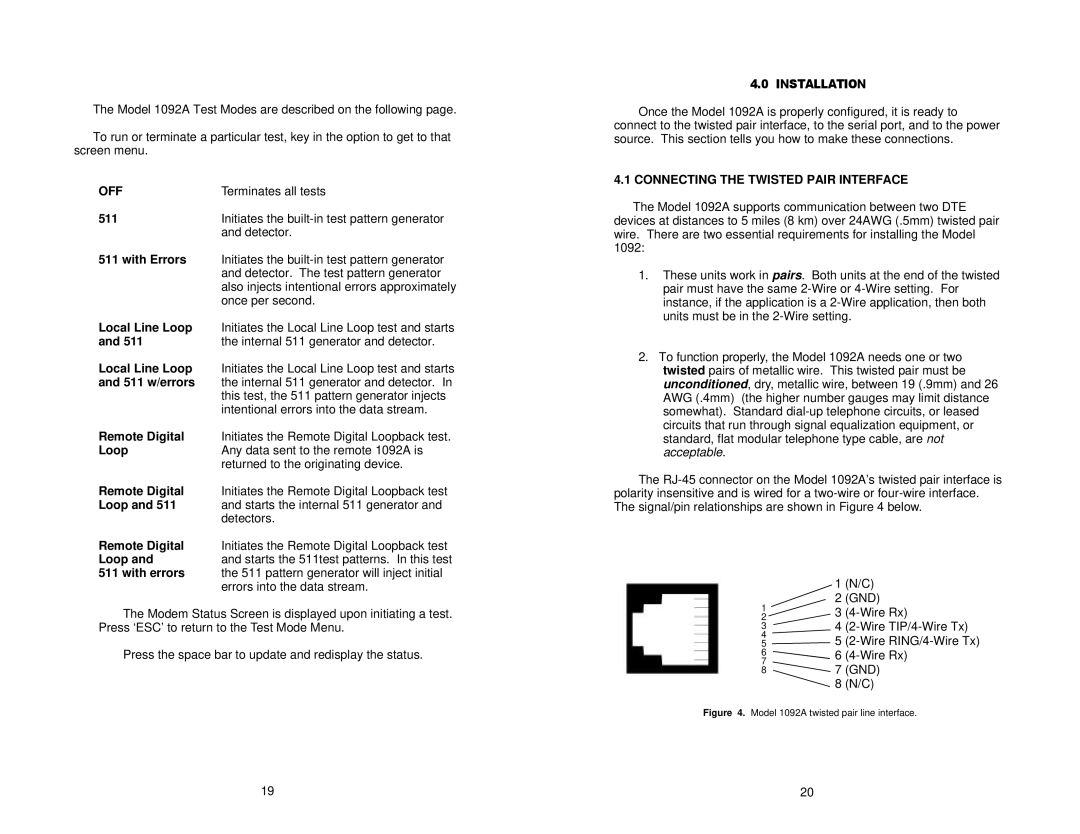
The Model 1092A Test Modes are described on the following page.
To run or terminate a particular test, key in the option to get to that screen menu.
OFF | Terminates all tests |
511 | Initiates the |
| and detector. |
511 with Errors | Initiates the |
| and detector. The test pattern generator |
| also injects intentional errors approximately |
| once per second. |
Local Line Loop | Initiates the Local Line Loop test and starts |
and 511 | the internal 511 generator and detector. |
Local Line Loop | Initiates the Local Line Loop test and starts |
and 511 w/errors | the internal 511 generator and detector. In |
| this test, the 511 pattern generator injects |
| intentional errors into the data stream. |
Remote Digital | Initiates the Remote Digital Loopback test. |
Loop | Any data sent to the remote 1092A is |
| returned to the originating device. |
Remote Digital | Initiates the Remote Digital Loopback test |
Loop and 511 | and starts the internal 511 generator and |
| detectors. |
Remote Digital | Initiates the Remote Digital Loopback test |
Loop and | and starts the 511test patterns. In this test |
511 with errors | the 511 pattern generator will inject initial |
| errors into the data stream. |
The Modem Status Screen is displayed upon initiating a test. Press ‘ESC’ to return to the Test Mode Menu.
Press the space bar to update and redisplay the status.
4.0 INSTALLATION
Once the Model 1092A is properly configured, it is ready to connect to the twisted pair interface, to the serial port, and to the power source. This section tells you how to make these connections.
4.1 CONNECTING THE TWISTED PAIR INTERFACE
The Model 1092A supports communication between two DTE devices at distances to 5 miles (8 km) over 24AWG (.5mm) twisted pair wire. There are two essential requirements for installing the Model 1092:
1.These units work in pairs. Both units at the end of the twisted pair must have the same
2.To function properly, the Model 1092A needs one or two twisted pairs of metallic wire. This twisted pair must be unconditioned, dry, metallic wire, between 19 (.9mm) and 26 AWG (.4mm) (the higher number gauges may limit distance somewhat). Standard
The
|
|
|
|
|
|
|
|
|
|
|
|
|
|
|
| 1 | (N/C) | ||
1 |
|
|
|
|
|
|
|
|
|
|
|
|
|
|
| 2 | (GND) | ||
|
|
|
|
|
|
|
|
|
|
|
|
|
|
| |||||
|
|
|
|
|
|
|
|
|
|
|
|
|
|
|
| 3 | |||
2 |
|
|
|
|
|
|
|
|
|
|
|
|
|
|
|
| |||
3 |
|
|
|
|
|
|
|
|
|
|
|
|
|
|
|
|
| 4 | |
4![]()
![]()
![]()
55
6![]()
![]()
![]()
![]()
![]()
![]()
![]() 6
6
7![]()
![]()
![]()
![]()
8![]()
![]()
![]()
![]()
![]()
![]()
![]()
![]()
![]()
![]() 7 (GND)
7 (GND)
![]()
![]()
![]()
![]()
![]() 8 (N/C)
8 (N/C)
Figure 4. Model 1092A twisted pair line interface.
19 | 20 |
